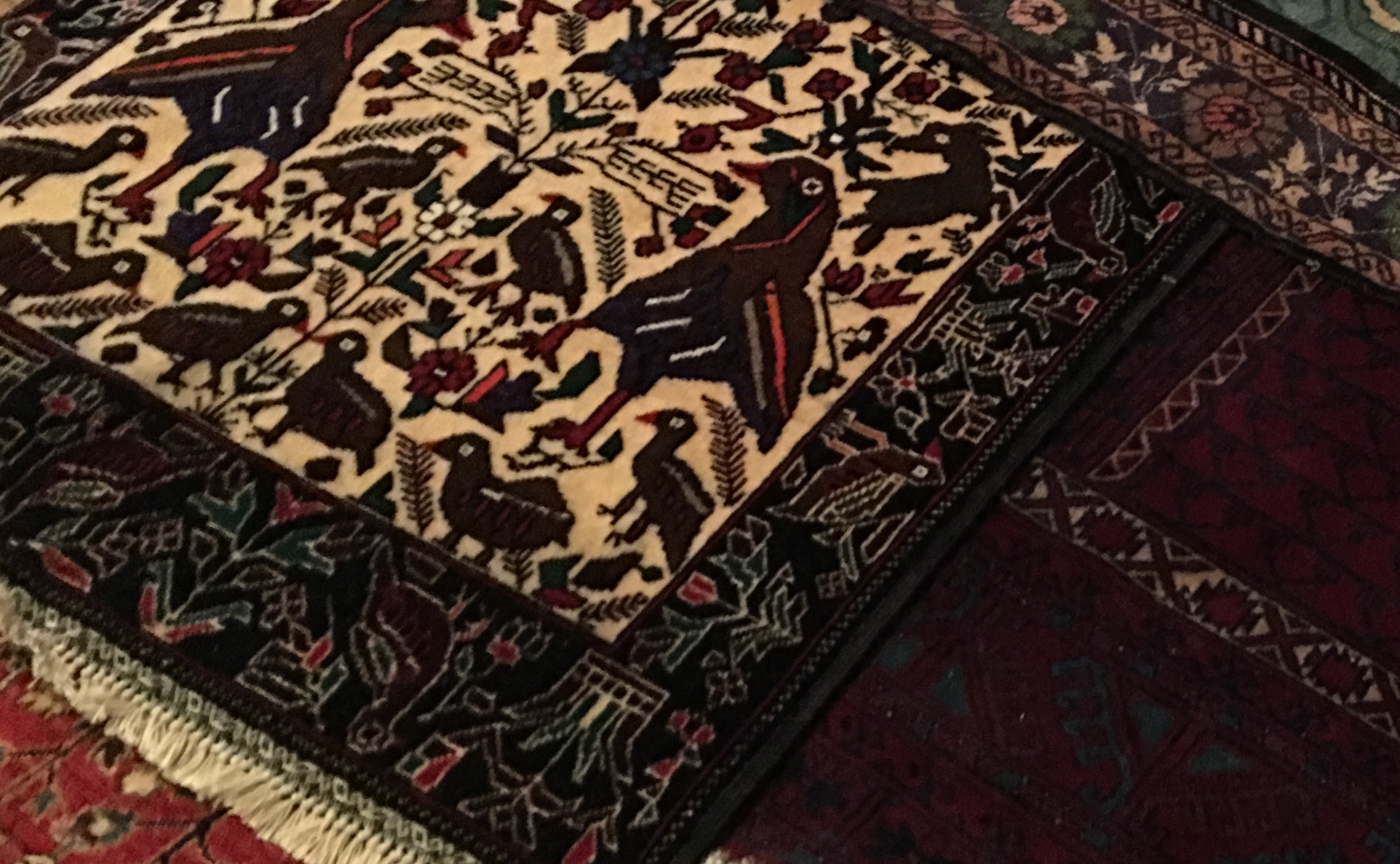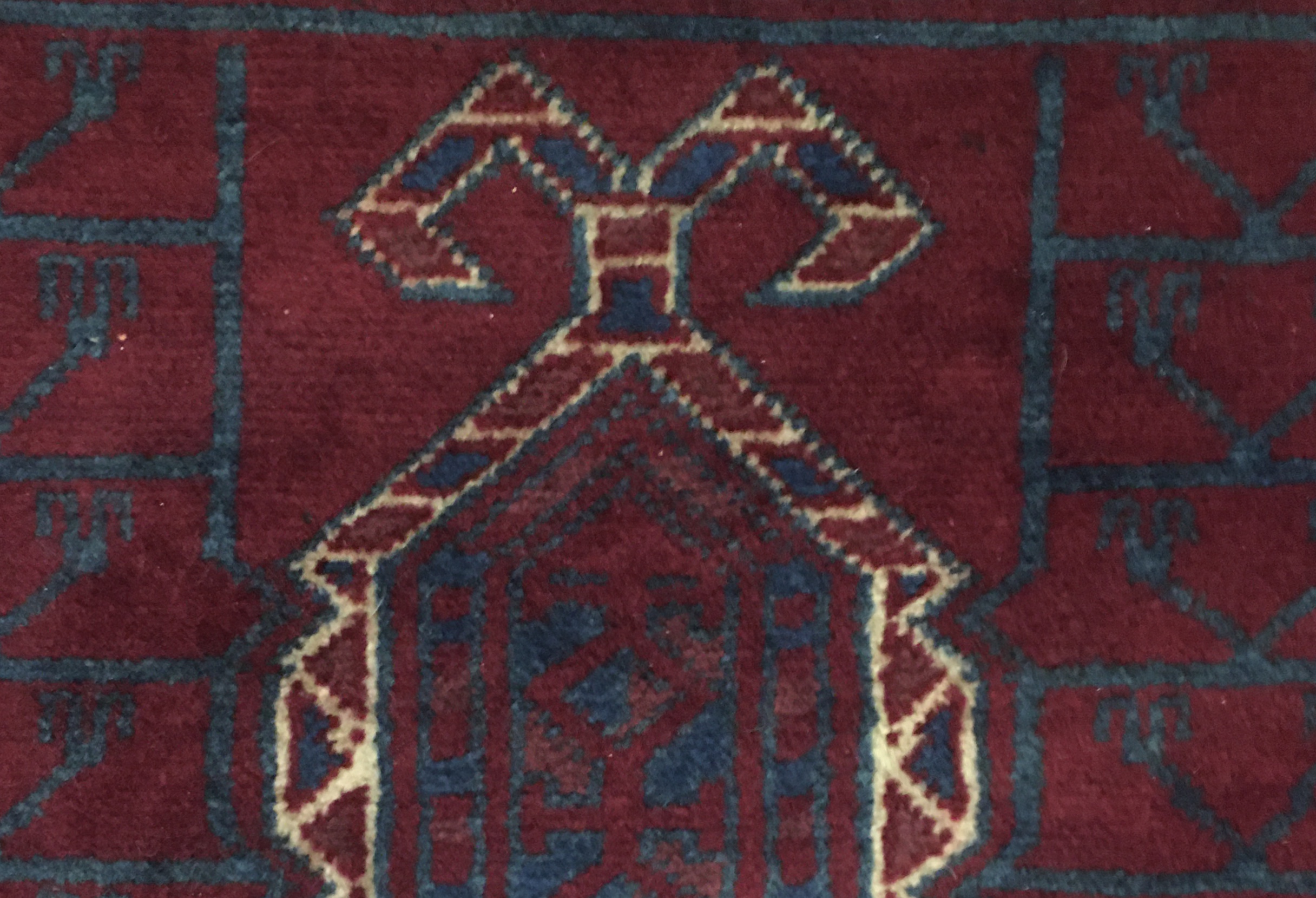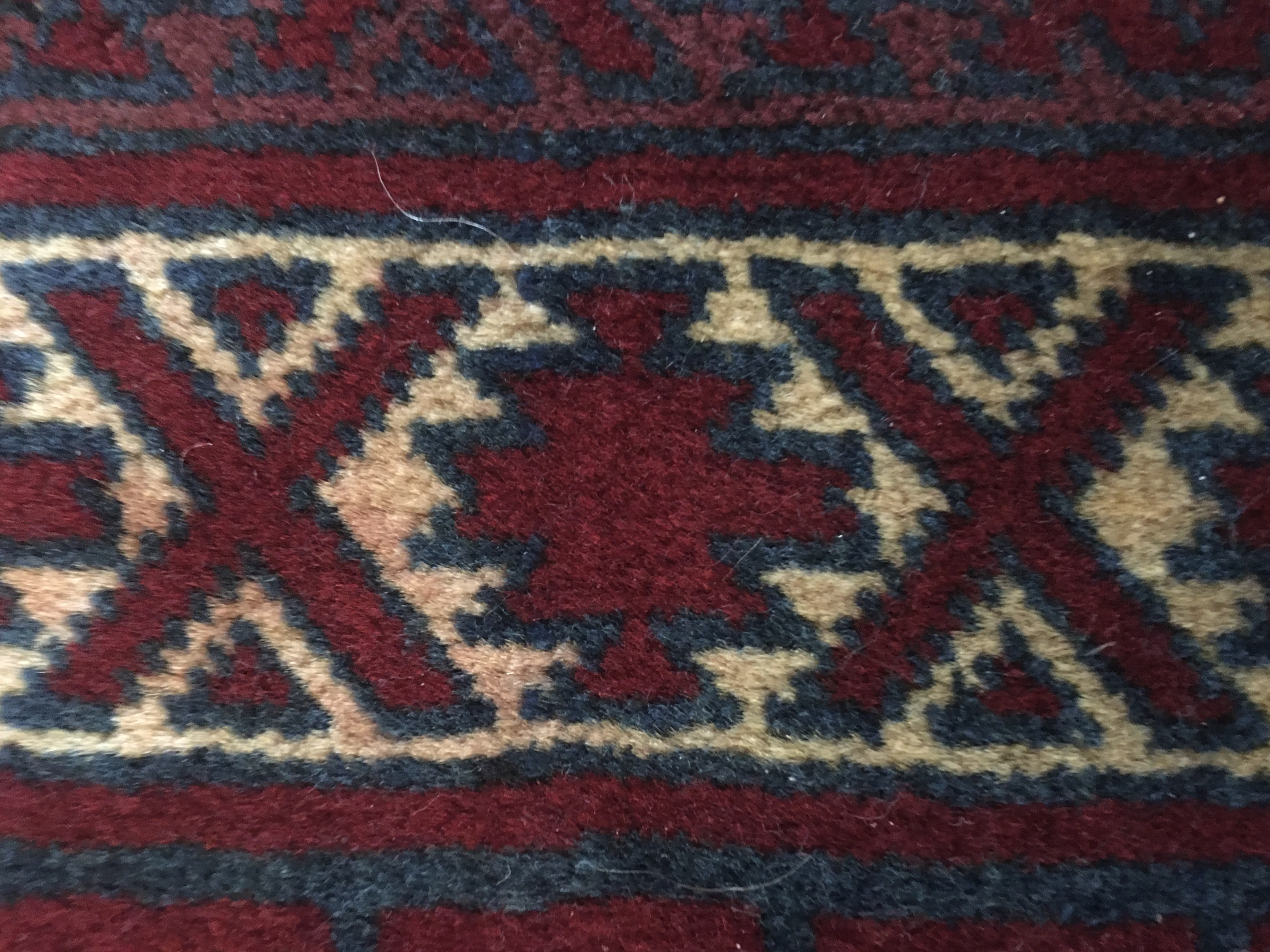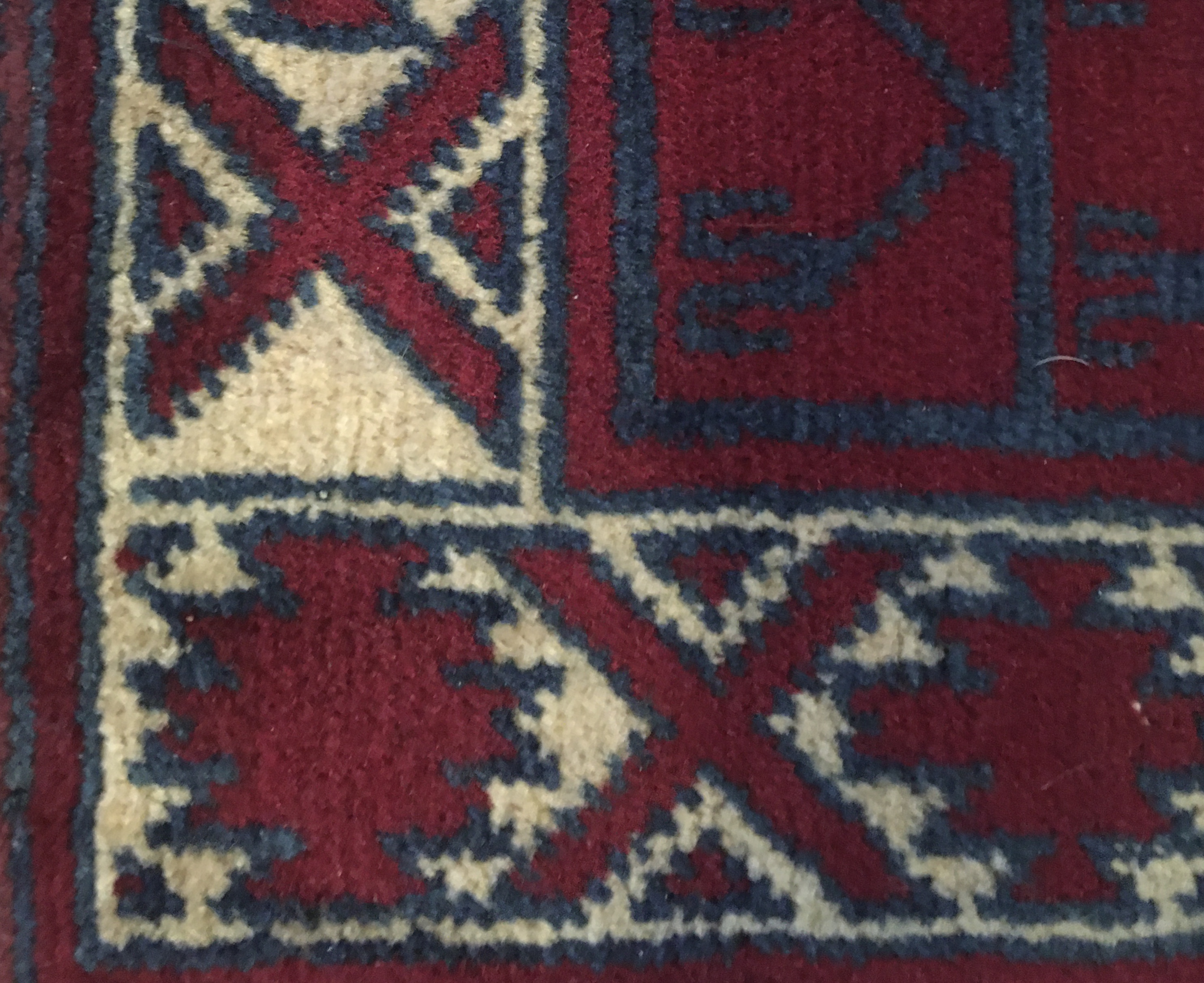
Check here for more information on the homepage rugs.
Nancy Small with Riyaz Bhat



Amos, Johanna, & Binkley, Lisa. (2020). Stitching and the self: Identity and the needle arts. Bloomsbury.
Archibald, Jo-ann, Lee-Morgan, Jenny Bol Jun, & De Santolo, Jason (Eds.). (2019). Decolonizing research: Indigenous storywork as methodology. Zed Books.
Azmat, Hirra. (2016, April 16). Riyaz Bhat: Kashmir's rug man. Kashmir Times Online. Retrieved November 10, 2021, from http://www.kashmirtimes.com/newsdet.aspx?q=51850
Beck, Estee. (2020). Discovering maker literacies: Tinkering with a constructionist approach and maker competencies. Computers and Composition, 58, 1–16. https://doi.org/10.1016/j.compcom.2020.102604
Cargile Cook, Kelli. (2002). Layered literacies: A theoretical frame for technical communication pedagogy. Technical Communication Quarterly, 11(1), 5–29. https://doi.org/10.1207/s15427625tcq1101_1
Charland, William. (2011). War rugs: Woven documents of conflict and hope. Art Education, 64(6), 25–32. https://doi.org/10.1080/00043125.2011.11519149
Choi, Amy S. (2015, March 17). How stories are told around the world. Ideas.TED.com. https://ideas.ted.com/how-stories-are-told-around-the-world/
Cooper, James Fenimore. (2012). Autobiography of a pocket handkerchief. In Jessica Hemmings (Ed.), The textile reader (pp. 99–116). Berg Publishing. (Original work published 1843)
Deacon, Deborah A. (2012). Textiles of war: Women's commentaries on conflict in Iraq and Afghanistan. In Proceedings of Textile Society of America 13th Biennial Symposium. https://digitalcommons.unl.edu/tsaconf/672
Denny, Walter B. (2014). How to read Islamic carpets. Yale University Press.
Department of Islamic Art. (2001, October). Figural representation in Islamic art. The Metropolitan Museum of Art. Retrieved November 10, 2021, from https://www.metmuseum.org/toah/hd/figs/hd_figs.htm
Elias, Jamal J. (2021, September 21). Afghanistan's war rug industry distorts the reality of everyday trauma. The Conversation. Retrieved November 10, 2021, from https://theconversation.com/afghanistans-war-rug-industry-distorts-the-reality-of-everyday-trauma-167608
Fayaz, Hossein. (2015). The girls from Afghanistan: Tales of war and love woven into the knots of a rug (Katherine Margaret Clifton, Trans.). Fayaz Editore.
Formenton, Fabio. (1972). Oriental rugs and carpets. McGraw-Hill.
Frye, Susan. (2010). Pens and needles: Women’s textualities in early modern England. University of Pennsylvania Press.
Glenn, Cheryl, & Enoch, Jessica. (2010). Invigorating historiographic practices in rhetoric and composition studies. In Alexis E. Ramsey, Wendy B. Sharer, Barbara L'Eplattenier, & Lisa S. Mastrangelo (Eds.), Working in the archives: Practical research methods for rhetoric and composition (pp. 11–27). Southern Illinois University Press.
Goggin, Maureen Daly. (2009). Introduction: Threading women. In Maureen Daly Goggin & Beth F. Tobin (Eds.), Women and the material culture of needlework and textiles, 1750–1950 (pp. 1–12). Ashgate.
Goggin, Maureen Daly, & Tobin, Beth Fowkes (Eds.). (2009a). Women and the material culture of needlework and textiles, 1750–1950. Ashgate.
Goggin, Maureen Daly, & Tobin, Beth Fowkes. (Eds.). (2009b). Women and things, 1750–1950: Gendered material strategies. Ashgate.
Gollihue, Krystin N. (2019). Re-making the makerspace: Body, power, and identity in critical making practices. Computers and Composition, 53, 21–33. https://doi.org/10.1016/j.compcom.2019.05.002
Gollihue, Krystin, & Xiong–Gum, Mai Nou. (2020). Dataweaving: Textiles as data materialization. Kairos: A Journal of Rhetoric, Technology and Pedagogy, 25(1). http://kairos.technorhetoric.net/25.1/disputatio/gollihue-xiong-gum/index.html
Haas, Angela. M. (2007). Wampum as hypertext: An American Indian intellectual tradition of multimedia theory and practice. Studies in American Indian Literatures, 19(4), 77–100. https://doi.org/10.1353/ail.2008.0005
Housego, Jenny. (1996). Tribal rugs (3rd ed). Interlink Books.
Itchuaqiyaq, Cara Uluak, & Matheson, Breeann. (2021). Decolonizing decoloniality: Considering the (mis)use of decolonial frameworks in TPC scholarship. Communication Design Quarterly, 9(1), 20–31. https://doi.org/10.1145/3437000.3437002
Kirsch, Gesa E., & Ritchie, Joy S. (2003). Beyond the personal: Theorizing a politics of location in composition research. In Gesa E. Kirsch, Faye Spencer Maor, Lance Massey, Lee Nickoson-Massey, & Mary P. Sheridan-Rabideau (Eds.), Feminism and composition: A critical sourcebook (pp. 140–159). Bedford/St. Martin's Press. (Original work published 1995)
Kirsch, Gesa E., & Rohan, Liz (Eds.). (2008). Beyond the archives: Research as lived process. Southern Illinois University Press.
Knoblauch, A. Abby. (2012). Bodies of knowledge: Definitions, delineations, and implications of embodied writing in the academy. Composition Studies, 40(2), 50–65.
Kodar, Zamza, Adilbeaeva, Aigul, Urankhaeva, Gulmira, & Baipeisova, Gulnar. (2018). Peculiarities of gender stratification in nomadic culture. Journal of Legal, Ethical and Regulatory Issues, (21)1, 1–6.
Kremmer, Christopher. (2002). The carpet wars: From Kabul to Baghdad. Harper Collins.
Khusraw and Shirin. (n.d.). Bodleian Libraries: University of Oxford. Retrieved November 10, 2021, from https://wayback.archive-it.org/6780/20210227212918/https://www.bodleian.ox.ac.uk/whatson/whats-on/online/love-and-devotion/khusraw-and-shirin
Lockett, Alexandria L., Ruiz, Iris D., Sanchez, James Chase, & Carter, Christopher. (2021). Race, rhetoric, and research methods. WAC Clearinghouse; University of Colorado Press. https://doi.org/10.37514/PER-B.2021.1206
Langton, Mary Beach. (1904). How to know Oriental rugs. D. Appleton and Co.
Mao, LuMing, Wang, Bo, Lyon, Arabella, Jarratt, Susan C., Swearingen, C. Jan, Romano, Susan, Simonson, Peter, Mailloux, Steven, & Lu, Xing. (2015). Manifesting a future for comparative rhetoric. Rhetoric Review, 34(3), 239–274. https://doi.org/10.1080/07350198.2015.1040105
Martinez, Aja Y. (2020). Counterstory: The rhetoric and writing of Critical Race Theory. Conference on College Composition and Communication/National Council of Teachers of English.
Mascelloni, Enrico. (2009). War rugs: The nightmare of Modernism. Skira Press.
Mater, Jassim. (2015, January 29). Unraveling the Afghan art of carpet weaving. Al Jazeera. Retrieved November 10, 2021, from https://www.aljazeera.com/features/2015/1/29/unravelling-the-afghan-art-of-carpet-weaving
McCabe, Alyssa. (1997). Cultural background and storytelling: A review and implications for schooling. The Elementary School Journal, 97(5), 453–473. https://doi.org/10.1086/461876
Moheban, Abraham Levi. (2016). The encyclopedia of antique carpets (Vols. 1–2; David Moheban, Ed.). Princeton Architectural Press.
Murphy, Brian. (2005). The root of wild madder. Simon and Schuster.
Neild, Barry. (2018a, March 7). See beautiful rugs from Riyaz Bhat in Doha. CNN Travel. Retrieved November 10, 2021, from https://www.cnn.com/travel/gallery/beautiful-doha-rugs-photos/index.html
Neild, Barry. (2018b). How the Indiana Jones of carpets became the Rug Man of Doha. CNN Travel. Retrieved November 10, 2021, from https://www.cnn.com/travel/article/rug-man-of-doha/index.html
Nizami. (1524–1525). Farhad carves a milk channel for Shirin, Folio 74 from a khamsa (quintet) of Nizami of Ganja. The Metropolitan Museum of Art. Retrieved October 14, 2020, from https://www.metmuseum.org/art/collection/search/446595
Opie, James. (1992). Tribal rugs. The Tolstoy Press.
Parsons, Richard D. (2016). The carpets of Afghanistan (4th ed.). ACC Art Books.
Pavry, Bapsy. (1930). The heroines of ancient Persia: Stories retold from the Shahnama of Firdausi. Cambridge University Press.
Royster, Jacqueline Jones. (1996). When the first voice you hear is not your own. College Composition and Communication, 47(1), 29–40. https://doi.org/10.2307/358272
Royster, Jacqueline Jones, & Kirsch, Gesa E. (2012). Feminist rhetorical practices: new horizons for rhetoric, composition, and literacy studies. Southern Illinois University Press.
Ruiz, Iris D. (2021). Critiquing the critical: The politics of race and coloniality in rhetoric, composition, and writing studies research traditions. In Alexandra L. Lockett, Iris D. Ruiz, Jason Chase Sanchez, & Christopher. Carter, Race, rhetoric, and research methods (pp. 39–79). WAC Clearinghouse; University of Colorado Press. https://doi.org/10.37514/PER-B.2021.1206
Rutt, Christine Gerber. (2015, October 14). Qatar shopping. The Telegraph. Retrieved November 10, 2021, from https://www.telegraph.co.uk/travel/destinations/middle-east/qatar/articles/qatar-shopping/
Scharff, Virginia. (2015). Empire and liberty in the middle of nowhere. In Virginia Scharff (Ed.), Empire and liberty: The Civil War and the West (pp. 140–158). University of California Press.
Sheridan, David Michael. (2010). Fabricating consent: Three-dimensional objects as rhetorical compositions. Computers and Composition, 27(4), 249–265. https://doi.org/10.1016/j.compcom.2010.09.005
Shirin and Farhad. (n.d.). Museum of Islamic Art. Retrieved November 10, 2021, from https://www.mia.org.qa/en/qajar-women/qajar-shirin-farhad
Shivers-McNair, Ann. (2020). Mediation and boundary marking: A case study of making literacies across a makerspace. Learning, Culture and Social Interaction, 24, 1–7. https://doi.org/10.1016/j.lcsi.2019.02.015
Showalter, Elaine. (1986). Piecing and writing. In Nancy K. Miller (Ed.), The poetics of gender (pp. 222–247). Columbia University Press.
Small, Nancy. (2017a). (Re)kindle: On the value of storytelling to technical communication. Journal of Technical Writing and Communication, 47(2), 234–253. https://doi.org/10.1177/0047281617692069
Small, Nancy. (2017b). Risking our foundations: Honor, codes, and authoritarian spaces. In Kevin Gray, Hasan Bashir, & Stephen Keck (Eds.), Western higher education in Asia and the Middle East: Politics, economics, and pedagogy (pp. 223–242). Rowan and Littlefield/Lexington Press.
Small, Nancy. (2022a). Importing lessons from Qatar: Towards a research ethic in transnational and intercultural TPC. In Nancy Small & Bernadette Longo (Eds.), Transnational research in technical communication: Stories, realities, and reflections (pp. 183–212). SUNY Press.
Small, Nancy. (2022b). A rhetoric of becoming: USAmerican women in Qatar. Parlor Press.
Smith, Linda Tuhiwai. (2012). Decolonizing methodologies: Research and Indigenous peoples (2nd ed.). Zed Books Ltd.
Spivak, Gayatri Chakravorty. (2012). Culture. In Jessica Hemmings (Ed.), The textile reader (pp. 277–285). Berg Publishing. (Original work published 1999)
Spooner, Brian. (2011). Afghan wars, Oriental carpets, and globalization. Expedition, 53(1), 11–20. http://repository.upenn.edu/anthro_papers/63
Stallybrass, Peter. (1993). Worn worlds: Clothes, mourning and the life of things. The Yale Review, 81(2), 35–50.
Stone, Peter. (2004). Tribal and village rugs: The definitive guide to design, pattern, and motif. Thames and Hudson.
Stone, Peter. (2013). Oriental rugs: An illustrated lexicon of motifs, materials, and origins. Tuttle Publishing.
Time Out Doha Staff. (2016, September 26). The Rug Man in Doha. Time Out Doha. Retrieved October 14, 2020, from http://www.timeoutdoha.com/shopping/features/73640-the-rug-man-in-doha
Tobin, Beth Fowkes, & Goggin, Maureen Daly. (2009). Introduction: Materializing women. In Maureen Daly Goggin & Beth Fowkes Tobin (Eds.), Women and things, 1750–1950: Gendered material strategies (pp. 1–14). Ashgate.
Turney, Joanne. (2009). The culture of knitting. Berg.
Tye, Aunty Lorraine, Akama, Yoko, Elliott, Linda, Keen, Seth, McMillan, Faye, McMillan, Mark, & West, Peter. (2020). Weaving and yarning sovereign relationships. Kairos: A Journal of Rhetoric, Technology and Pedagogy, 24(2). http://kairos.technorhetoric.net/24.2/inventio/tye-et-al/index.html
Tzareva, Elena. (1984). Rugs and carpets from Central Asia: The Russian collections. Penguin Books.
Willis, Rebecca. (2019). The use of composite narratives to present interview findings. Qualitative Research, 19(4), 471–480. https://doi.org/10.1177/1468794118787711
Wilson, Shawn. (2008). Research is ceremony: Indigenous research methods. Fernwood Publishing.
Windchief, Sweeney, & San Pedro, Timothy. (2019). Applying Indigenous research methods: Storying with peoples and communities. Routledge.
Yancy, George. (2008). Colonial gazing: The production of the body as "Other." Western Journal of Black Studies, 32(1), 1–15.